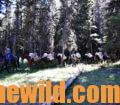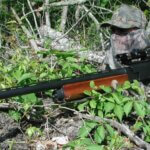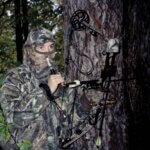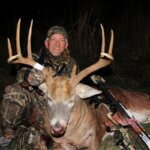Editor’s Note: At first glance, you don’t expect an attractive, 5’2” lady to be an elk outfitter and guide who not only can find, call in a bull elk, field dress the animal, pack out the meat and take care of the horses, the humans and the animals in the high mountains of southwest Colorado. But Mia Anstine of Pagosa Springs, Colorado, also is a writer, photographer, mother and wife. According to Mia, “I’ve hunted elk as far back as I could remember. I’d tag along with my dad when he hunted elk. I’ve been hunting elk as an adult for the last 22 years. I started my guiding career about 12-years ago and guide mainly for Wolf Creek Outfitters (https://www.gohunt.com/outfitter/wolf-creek-outfitters-inc), a few non-profit organizations and some landowners in my area. I’m also a licensed outfitter. Wolf Creek Outfitters hunts in southwest Colorado, all on private property.”
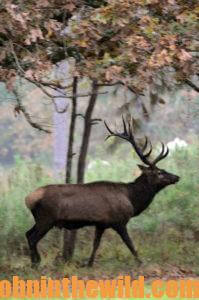 On the first morning of my hunt at the unit near our home, I had the opportunity to take a 5×5 bull that would score about 335 inches. He was a beautiful (see Day 3), magnificent bull that I would have taken anytime and anywhere. I had my bow up, an arrow nocked and my mechanical release on my bow string. All I had to do was draw and shoot. Hank whispered, “Don’t shoot.” I still had the option to take that bull. However, I knew that my daughter Lea had told my husband that, “On this hunt, your main job is to not let Mom shoot the first good bull she sees.” The most-difficult part of this 18-day hunt was to wait on an even-better trophy bull.
On the first morning of my hunt at the unit near our home, I had the opportunity to take a 5×5 bull that would score about 335 inches. He was a beautiful (see Day 3), magnificent bull that I would have taken anytime and anywhere. I had my bow up, an arrow nocked and my mechanical release on my bow string. All I had to do was draw and shoot. Hank whispered, “Don’t shoot.” I still had the option to take that bull. However, I knew that my daughter Lea had told my husband that, “On this hunt, your main job is to not let Mom shoot the first good bull she sees.” The most-difficult part of this 18-day hunt was to wait on an even-better trophy bull.
Before, I’d always been a meat hunter. My motto was, “If you see a nice bull, go ahead, and take it because you may not see another nice bull that season.” Some of my friends who’d taken record-book animals had told me the only way I could take a trophy animal was to pass up some bulls I normally would love to harvest. So, for me having the opportunity to take this nicer bull was difficult for me to let this bull walk. I would have been excited and proud to shoot this bull, but my husband was supposed to remind me to not take a really-good bull but instead wait for a trophy bull. There were numbers of huge bulls where we were hunting. I didn’t realize how many trophy bulls were in that section of land. So, the most-difficult part of the hunt for me wasn’t climbing mountains 12,000 feet in altitude – but rather watching bulls within easy bow range that would cause my heart to pound. I had to walk away and not take the shot because they weren’t trophy bulls.
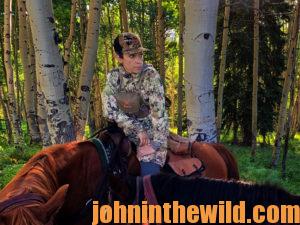 During the hunt, I stalked bulls bigger than the 5×5, but the wind and the other elk in the herd for some reason wouldn’t allow me to get close enough to those bigger bulls to make a shot. On an average day, I’d stalk a trophy bull in the morning before 9:00 am, but either cows would spook him, or the wind would change. When I couldn’t get a shot, I’d be down emotionally. But often as we started walking out of an area, we’d hear another bull bugle and go after him but find him to be too small. Then, after lunch, we usually would locate another bull, I’d make a stalk on him and sometimes would get close enough to take the shot but not take him due to his size.
During the hunt, I stalked bulls bigger than the 5×5, but the wind and the other elk in the herd for some reason wouldn’t allow me to get close enough to those bigger bulls to make a shot. On an average day, I’d stalk a trophy bull in the morning before 9:00 am, but either cows would spook him, or the wind would change. When I couldn’t get a shot, I’d be down emotionally. But often as we started walking out of an area, we’d hear another bull bugle and go after him but find him to be too small. Then, after lunch, we usually would locate another bull, I’d make a stalk on him and sometimes would get close enough to take the shot but not take him due to his size.
I teach students and people who come to my seminars to never take a shot unless they know for sure they can put that animals down quickly at a certain distance. I can make an effective deadly shot on a 3-D archery target at 100 yards. However, when I’m hunting elk, I limit myself to taking a shot that’s 30 yards or less.
During this 18-day hunt, we’d take a break generally after a full day of hunting – perhaps once a week – pack up our camp, come out of the mountains on our horses, get refreshed, eat some good meals and then return a day or two later. Taking those breaks was good for us to stay alert and hunt hard. Some days we’d leave our camp and hike deeper into the mountains, and on other days, we’d ride our horses deeper in the mountains and listen for elk to bugle. When we heard an elk bugle, we’d tie up the horses and go after the elk.
On some mornings, we’d decide to hunt a valley we hadn’t hunted before. We’d ride the horses to reach that valley. However, many times, we’d hear a bull bugle before we reached the location we’d planned to hunt. At that point, we’d tie up the horses, wait until shooting light and try to determine exactly where the bull was, and which way the wind was blowing to make a stalk. Often the wind would change before we reached the bull. Sometimes there were too-many elk between the bull and us, and we couldn’t get close enough to the bull I wanted to take. With all those eyes on us, we knew if we tried to make a stalk, we’d spook the herd and the bull. We’d have to back out, or the bull would disappear before we could get close enough to make a shot.
I’ve learned over the years, that the more eyes you have looking at you, the less chance you have to get within archery range of the bull elk you’re trying to take. The good news is that during that entire 18-day hunt, we only saw one other hunter – a muzzleloader hunter. Muzzleloader season overlapped a portion of our archery-only season. The unit we were hunting covered two different counties in Colorado. So, there was plenty of room to hunt without seeing other hunters, and because we were so deep in the mountains, we rarely saw any other hunters.
When I go on a personal elk hunt, we usually take two riding horses and two pack horses, a lightweight canvas tent, two bedrolls, two boxes of food and other miscellaneous items. Once we get our camp set-up, we usually hunt out of that camp. If we’re hunting on horseback, we’ll carry the two pack horses with us when riding into the back country. Then if I get a bull, we’ll have the pack horses with us to help carry the meat and the trophy out of the mountains.
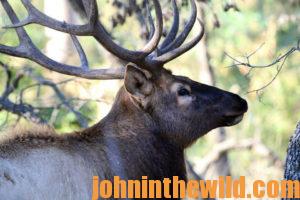 The Elk Dictate the Plan for the Hunt:
The Elk Dictate the Plan for the Hunt:
Once we hear a bugle and decide to go after that bull, the bull dictates the plan of how we get to within bow range. When we went to bed one night we’d planned to get up early before daylight, saddle up our horses and ride into a new canyon. However, before we had our animals ready to ride, we heard elk bugling, above our camp. We made the decision to wait until we had enough light to see and then go after the bulls bugling above us. We made a stalk and spotted a huge bull that would score about 380 inches on the Pope and Young scale (https://pope-young.org/). This bull had a harem of about 30 cows and seven or eight smaller bulls, (satellite bulls) that were constantly trying to pick up one or two cows without having to fight the herd bull for the right to try and bread them. Often the herd bull would see one of the satellite bulls trying to mount one of his cows, and he’d get angry and charge him. So, while we were watching the herd, the big bull was pulling his cows to the left and then pushing them to the right to try and keep the cows away from the younger, smaller bulls.
As we moved in, getting closer and closer to the herd bull, my husband would call, and I would call. Finally, when I got as close as I could to the big bull, I knew that I couldn’t go any further because I’d have to come out from under the cover I was using to keep the bull from seeing me. I decided to hold my position and let my husband call and move behind me, to try and pull the herd bull to me. Finally, the big bull was 80-yards away from where I was sitting. At home, I could place my arrow in the kill zone of a target at 100 yards. But I never take a shot at a bull unless he’s at 30-yards or less. The whole time I was watching this magnificent herd bull, I was thinking if I just had my muzzleloader this bull easily would be within range, and I could take this trophy elk of a lifetime. However, the elk left our area and went over the top of the ridge. This stalk was another one of those high-adrenaline moments that made elk hunting memories. This stalk happened about midway of our 18-day hunt.
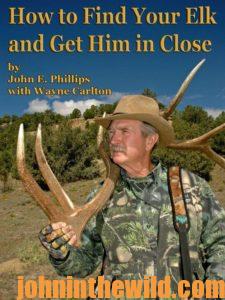 To learn more about elk hunting, check out John E. Phillips’ book, “How to Find Your Elk and Get Him in Close,” available in Kindle, print and Audible versions at http://amzn.to/17ENNqK. You may have to copy and paste this click into your browser. (When you click on this book, notice on the left where Amazon allows you to read 10% of the book for free and hear 10% of the book for free).
To learn more about elk hunting, check out John E. Phillips’ book, “How to Find Your Elk and Get Him in Close,” available in Kindle, print and Audible versions at http://amzn.to/17ENNqK. You may have to copy and paste this click into your browser. (When you click on this book, notice on the left where Amazon allows you to read 10% of the book for free and hear 10% of the book for free).
John E. Phillips has published several more books this fall and winter of 2020 you’ll enjoy.
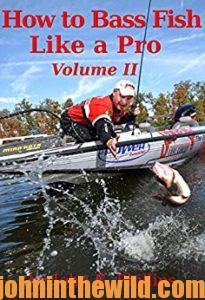 1) “How to Bass Fish Like a Pro, Volume II” – available in Kindle and print at https://www.amazon.com/gp/product/B08LBD7M4G/ref=dbs_a_def_rwt_hsch_vapi_taft_p5_i2
1) “How to Bass Fish Like a Pro, Volume II” – available in Kindle and print at https://www.amazon.com/gp/product/B08LBD7M4G/ref=dbs_a_def_rwt_hsch_vapi_taft_p5_i2
In “How to Bass Fish Like a Pro, Volume II,” you’ll learn tips and tactics from 21+ Bassmaster Classic winners, two Major League Fishing champions and 20+ Bassmaster Anglers of the Year about some of the dramatic changes in bass fishing.
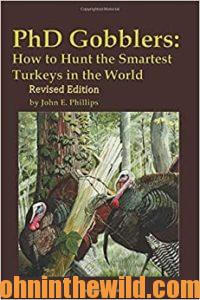 2) “PhD Gobblers: How to Hunt the Smartest Turkeys in the World, Revised Edition” – available in Kindle, Print and Audible at https://www.amazon.com/gp/product/B083V83RLG/ref=dbs_a_def_rwt_hsch_vapi_taft_p4_i8
2) “PhD Gobblers: How to Hunt the Smartest Turkeys in the World, Revised Edition” – available in Kindle, Print and Audible at https://www.amazon.com/gp/product/B083V83RLG/ref=dbs_a_def_rwt_hsch_vapi_taft_p4_i8
Turkeys that have earned their PhDs in the turkey-hunting wars know more about hunter-dodging than most hunters know about turkey hunting. These turkeys have built such a huge database on humans they’ve earned their PhDs.
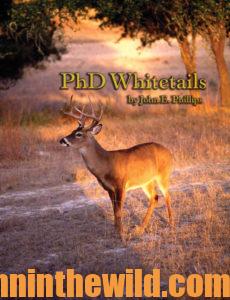 3) “PhD Whitetails” – available in Kindle and Print and soon to be in Audible at https://www.amazon.com/gp/product/1979793387/ref=dbs_a_def_rwt_hsch_vapi_taft_p7_i3
3) “PhD Whitetails” – available in Kindle and Print and soon to be in Audible at https://www.amazon.com/gp/product/1979793387/ref=dbs_a_def_rwt_hsch_vapi_taft_p7_i3
To become a “PhD Whitetail,” a whitetail deer has to have gone to school on hunters. He knows when to move, where to move, and how to move to avoid detection. The professional hunters in this book have spent their lifetimes finding these bucks with doctorates.
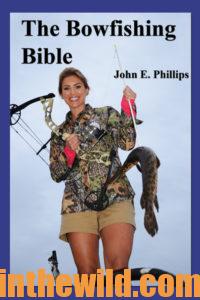 4) “The Bowfishing Bible” – available in Kindle, Print and Audible at
4) “The Bowfishing Bible” – available in Kindle, Print and Audible at
https://www.amazon.com/gp/product/B01D566HM0/ref=dbs_a_def_rwt_hsch_vapi_taft_p4_i1
This book doesn’t promise salvation or a ticket to heaven, but it does give you much of the information you need to be a happy, successful, productive and winning bowfisherman.
 5) “The Briar Patch Philosopher” – available in Kindle, Print and Audible at https://www.amazon.com/gp/product/B00MX0ZODI/ref=dbs_a_def_rwt_hsch_vapi_taft_p5_i4
5) “The Briar Patch Philosopher” – available in Kindle, Print and Audible at https://www.amazon.com/gp/product/B00MX0ZODI/ref=dbs_a_def_rwt_hsch_vapi_taft_p5_i4
Some of the reviews for this book include statements like, “I find myself looking through these wonderful thoughts about life, courage, love, children and God. This collection of sayings are very useful in helping me control my emotions. Some of my favorites include:
“Feelings change, Truth remains.”
“Embrace fear, because it’s an excellent motivator.”
“Life is a race. The beginning, we can’t control, and the end can’t be determined. But how well we run in the middle is all that counts. ”
Tomorrow: When Mia Anstine Took a Huge Birthday Bull Elk

